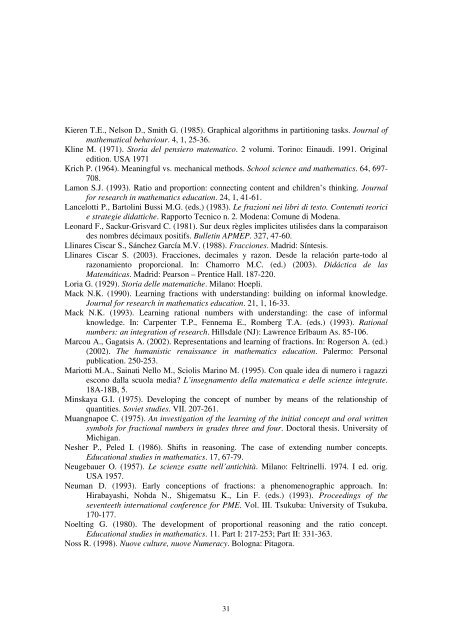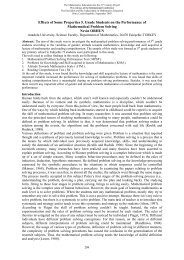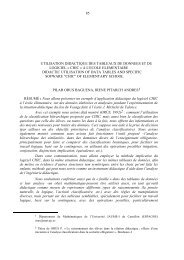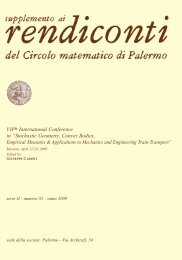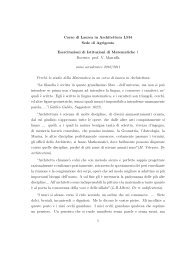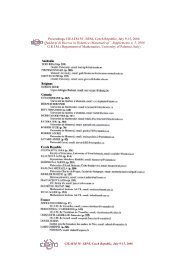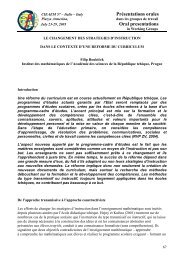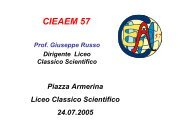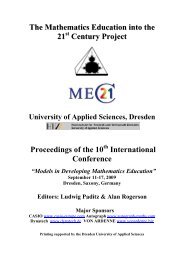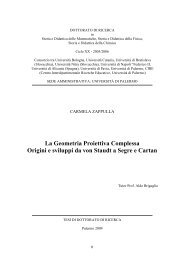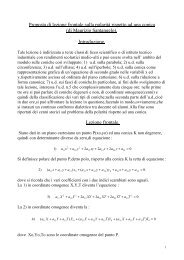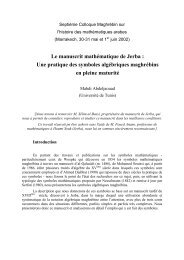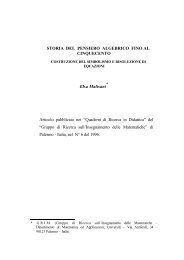CONTENTS - Dipartimento di Matematica e Informatica
CONTENTS - Dipartimento di Matematica e Informatica
CONTENTS - Dipartimento di Matematica e Informatica
Create successful ePaper yourself
Turn your PDF publications into a flip-book with our unique Google optimized e-Paper software.
Kieren T.E., Nelson D., Smith G. (1985). Graphical algorithms in partitioning tasks. Journal of<br />
mathematical behaviour. 4, 1, 25-36.<br />
Kline M. (1971). Storia del pensiero matematico. 2 volumi. Torino: Einau<strong>di</strong>. 1991. Original<br />
e<strong>di</strong>tion. USA 1971<br />
Krich P. (1964). Meaningful vs. mechanical methods. School science and mathematics. 64, 697-<br />
708.<br />
Lamon S.J. (1993). Ratio and proportion: connecting content and children’s thinking. Journal<br />
for research in mathematics education. 24, 1, 41-61.<br />
Lancelotti P., Bartolini Bussi M.G. (eds.) (1983). Le frazioni nei libri <strong>di</strong> testo. Contenuti teorici<br />
e strategie <strong>di</strong>dattiche. Rapporto Tecnico n. 2. Modena: Comune <strong>di</strong> Modena.<br />
Leonard F., Sackur-Grisvard C. (1981). Sur deux règles implicites utilisées dans la comparaison<br />
des nombres décimaux positifs. Bulletin APMEP. 327, 47-60.<br />
Llinares Ciscar S., Sánchez García M.V. (1988). Fracciones. Madrid: Síntesis.<br />
Llinares Ciscar S. (2003). Fracciones, decimales y razon. Desde la relación parte-todo al<br />
razonamiento proporcional. In: Chamorro M.C. (ed.) (2003). Didáctica de las<br />
Matemáticas. Madrid: Pearson – Prentice Hall. 187-220.<br />
Loria G. (1929). Storia delle matematiche. Milano: Hoepli.<br />
Mack N.K. (1990). Learning fractions with understan<strong>di</strong>ng: buil<strong>di</strong>ng on informal knowledge.<br />
Journal for research in mathematics education. 21, 1, 16-33.<br />
Mack N.K. (1993). Learning rational numbers with understan<strong>di</strong>ng: the case of informal<br />
knowledge. In: Carpenter T.P., Fennema E., Romberg T.A. (eds.) (1993). Rational<br />
numbers: an integration of research. Hillsdale (NJ): Lawrence Erlbaum As. 85-106.<br />
Marcou A., Gagatsis A. (2002). Representations and learning of fractions. In: Rogerson A. (ed.)<br />
(2002). The humanistic renaissance in mathematics education. Palermo: Personal<br />
publication. 250-253.<br />
Mariotti M.A., Sainati Nello M., Sciolis Marino M. (1995). Con quale idea <strong>di</strong> numero i ragazzi<br />
escono dalla scuola me<strong>di</strong>a? L’insegnamento della matematica e delle scienze integrate.<br />
18A-18B, 5.<br />
Minskaya G.I. (1975). Developing the concept of number by means of the relationship of<br />
quantities. Soviet stu<strong>di</strong>es. VII. 207-261.<br />
Muangnapoe C. (1975). An investigation of the learning of the initial concept and oral written<br />
symbols for fractional numbers in grades three and four. Doctoral thesis. University of<br />
Michigan.<br />
Nesher P., Peled I. (1986). Shifts in reasoning. The case of exten<strong>di</strong>ng number concepts.<br />
Educational stu<strong>di</strong>es in mathematics. 17, 67-79.<br />
Neugebauer O. (1957). Le scienze esatte nell’antichità. Milano: Feltrinelli. 1974. I ed. orig.<br />
USA 1957.<br />
Neuman D. (1993). Early conceptions of fractions: a phenomenographic approach. In:<br />
Hirabayashi, Nohda N., Shigematsu K., Lin F. (eds.) (1993). Procee<strong>di</strong>ngs of the<br />
seventeeth international conference for PME. Vol. III. Tsukuba: University of Tsukuba.<br />
170-177.<br />
Noelting G. (1980). The development of proportional reasoning and the ratio concept.<br />
Educational stu<strong>di</strong>es in mathematics. 11. Part I: 217-253; Part II: 331-363.<br />
Noss R. (1998). Nuove culture, nuove Numeracy. Bologna: Pitagora.<br />
31


